For some contemporary pictures here are visits by
Mark Rowlinson’s
http://golfclubatlas.com/forum/index.php/topic,14790.0/Philip Gawith too
http://golfclubatlas.com/forum/index.php/topic,20825.0/ (Didn’t Sean give us his take? Can’t find it)
There was a recent excellent comparison between Huntercombe 1901 by Willie Park and Swinley Forrest 1909 by Colt. The subject of Colts changes to Parks Sunningdale (also 1901) was raised.
Huntercombe thread.
http://golfclubatlas.com/forum/index.php/topic,43551.0/Here’s Tom Mac Wood on the breakthrough that Sunningdale and Huntercombe represented.
Like most of his fellow architects at that time Park’s success (or lack of success) could easily be predicted. When given good material near the sea he produced good results, when given an ordinary inland site he did nothing of consequence ”that is until 1899. That year he began Sunningdale, and it was a major advancement. It was considered revolutionary for two primary reasons: first its scale was enormous for that time, and secondly the severity of the site, not only topographically but also in the nature of the ground. At that time it was considered unadvisable to make a course over sandy ground overgrown with heather. Sunningdale was the first course to be wholly sown from seed, at a considerable cost I might add.
Soon after being engaged at Sunningdale Willie began Huntercombe, and it was another breakthrough design. Huntercombe was unusual for its use of hazards “ man-made and natural “ strategically placed in central and flanking locations. These two courses were constructed simultaneously, and Willie reportedly made frequent trips back to Musselbourgh seeking inspiration. That was a novel approach as well. Both Sunningdale and Huntercombe opened to positive reviews in 1901, and were tremendous improvements over the dreaded Victorian courses, but one should not get the impression they were polished gems. Golf architecture improved incrementally not overnight
So although Huntercombe was the first to be ready it possibly benefitted from lessons learned in planning Sunningdale first. The two sites also have remarkably different terrain for sandy inland heaths, 30 miles apart. The kind of blindness described below was barely an option at the much flatter Huntercombe, where there is subtle part blindness (falling away greens). If Huntercombe took its inspiration from Musselburgh, then perhaps the blindness and large greens at Sunningdale were channelling The Old Course, with a double green the ‘tell’?
You frequently read comments vaguely referring to changes Colt made at Sunningdale, where he was the first Secretary. After a decade or so his ties to the club lessened but they used him when they needed a second course in 1922 and “the committee” for the most part continued to listen to him.
A few opinions
Dickinson wrote “Many people believe Sunningdale Old Course to be the finest inland golf course in England. I am among that number...” and “Sunningdale has hardly been altered since Willie Park laid it out in 1900.”
Horace Hutchinson “Harry Colt had by that time gone to Sunningdale, and was making improvements on the original plan of Willy Park.”
The American Golfer 1920 (not sure which month!) pg36 ‘Echoes from British Links’.
Quoting a letter from AC Croome in the Morning Post. “Among the many services which Mr Harry Colt rendered to the Sunningdale Club must be reckoned the modifications of several holes by reduction of their more gigantic features. For example, the putting green of the first, sixth, eleventh, twelfth, and fifteenth holes are about half the size of those originally constructed, and the play of them has consequently gained much in interest.”
The American Golfer March 1917 Park and the Past by Henry Leach pg 357. “He was responsible for the primary design of the latter (Sunningdale), a beautiful course cut out of a wilderness of heather on some high, rolling land in Berkshire. Mr Colt soon set himself to work on the first designs when they had been applied, and he has carried out vast improvements n the original model, so that Sunningdale as we know it now, the inland course that I still consider as the best and most delightful to play upon in the whole of Britain is not at all what was at first. Still Willie was in at the beginning with Sunningdale; that is a lasting distinction.”
I’ve looked at two main sources
The club Centenary History. Unfortunately I find this a major disappointment in so many ways but it’s the most authoritative guide we currently have. Comments on changes to each hole listed below.
Darwin started The Golf Courses of The British Isles 1901 with a lengthy review of the course – his comments in italics. NB it’s worth remembering that Colt was a friend of Darwin and it may explain the unusually outspoken comments below.
It should also be noted that changes to 1 & 18 in 1922 were required to create space for the second course.
1
Original tee roughly where the 18 Green is now 1922
Shared a large green with 17 until 1907, nearer heather banks than at present. The ditch that partly still exists ran across the hole in front of the green and had to be carried. IN 1910 THE PART GUARDING THE GREEN WAS FILLED IN AND THE GREEN MOVED TO its CURRENT POSITION.
1922 bunker added LHS of green
Bank lowered – ditch in front of green removed.
1910 green moved
1928 second small bunker added ON LEFT SLOPE
1955 2 bunkers by green merged.
2
Tee pushed back several times.
Bunkers on the right of the fairway removed 1960
1928 bunker 150 yards short of green added.
Green slopes front to back and in 1961 the bunker on the left of the green was extended to the right, and more into the green.
3
Little altered, lengthened. A bunker left of the green was removed in 1960 and the hollow left with grass and heather.
Darwin described it “There is a bunker that “pokes and nuzzles with its nose” into the left-hand or top edge of the green, and he who pulls this drive ever so slightly will have a more difficult pitch to play over the bunker into a somewhat slippery and sloping green that runs away from him”
4
1910 green moved to right from lower ground. The tee was far right and practically a blind shot
Darwin describing the old hole “as short hole on a plateau green some way above the player. The plateau is reasonably small and well guarded...a better hole than it was, maybe, but not quite worthy of Sunningdale yet.”
5
As 4th green was constructed tee had to be moved to the right
5th green moved to right “at same time” putting pond more in play. Fairway bunkers added and pond enlarged 60’s and 70’s. Sleepers added 1996
6
Until 1961 two cross bunkers guarded the green.
Darwin “Another wonderfully good two-shot hole is the sixth, where the green lies in an angle of a wood, and we must hole our second shot well up to the left so that the ball shall trickle slowly down the sloping green towards the hole...”
See also Croome above.
7
Drive was blind over a large bunker now disused in the hill. The second shot was also blind, a dog leg left over another now disused bunker to a green in the hollow.
Alterations discussed in 1908, (green was too wet) but not changed until 1922. New current green decided upon by the committee. It seems for a while the old was kept as an alternative.
Darwin The seventh is a bone of contention, some averring that it is a fine ‘sporting hole’, while others have no names too bad for it...Those who like a blind tee-shot and a blind second will admire it, and those who don’t won’t and there is the whole mater in a very small compass.”
8
Unspecified criticism from 1906
So when 7 G move hole redesigned 8th was realigned and left hand greenside bunker enlarged and brought more into the green. Since lengthened and in 1970 the greenside bunkering extended.
Darwin n The Golf Courses of the British Isles (1910) wrote “The eight is quite a good short hole now (it used to be bad and blind and stupid)”
9
Nothing significant until 1981 when a two tier green constructed
10
Sometime before WW11 fairway bunker moved nearer the green. Later a new back tee added.
Ouimet putting on the 10th in 1917
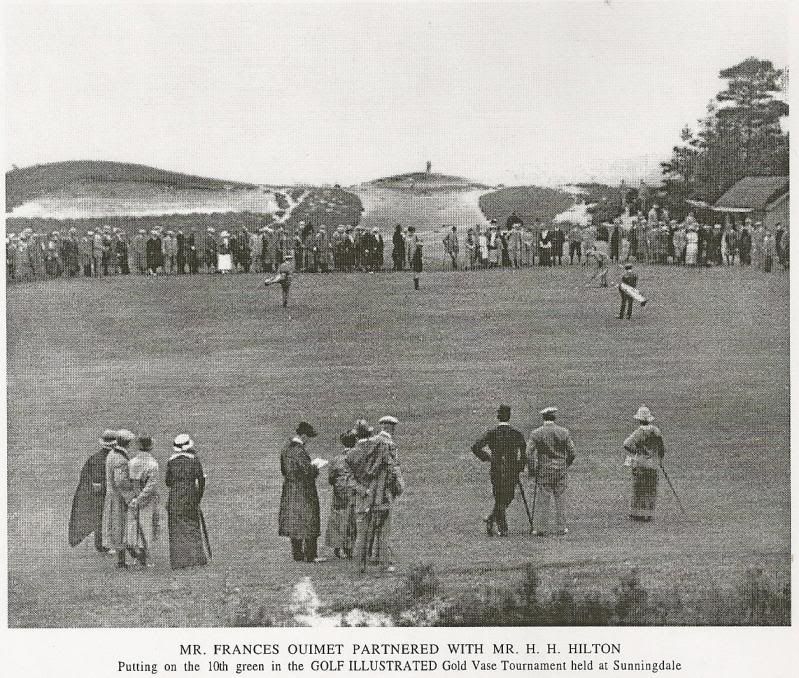
11
Originally a large green on fairway level.
1910 the committee decided to make a double plateau with a hollow between.
“Left hand green” abandoned by 1922
1928 a bunker was made in the hollow in the left face of the green. IN 1992 a controversial change involved removing a heather bank and hollow to the right of the green. This was extended to a ditch.
12
Original Green was low and to right of existing green dating from 1911 with a mound created in the right face. A RHS fairway bunker was added in 1921 and later taken out of use. As second one was added and later moved neared to the fairway.
1921 Bunker added to fairway.
13
Original hole played at 260 yards blind over a hill. 1907 shortened to 160 yards from top of hill. Green was larger with a small bunker in centre “Colts Po” When green was later reduced behind bunker, bunker was enlarged. The grassy hollow on the right of green there from the start but left hand one added 1970
Darwin “Once one of the very worst holes in the world, and is now a thoroughly attractive one.”
Parks original green was originally mowed as a square?
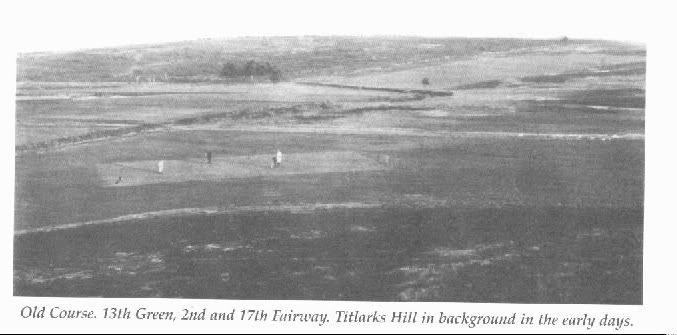
Today

14
Little change Two bunkers disused one to left and one to right in the oblique line crossing fairway. Fairway narrowed over time
(Edit oblique lines of Bunkers are surely a Colt signature?)
15
Second set of tee added to left of 14 green in 1918. Green originally much larger coming forward
16
Fairway narrowed over time.
17
Double green wasn’t large enough. 1907 moved to right of present position.
1922 current green created to allow room for New Course.
“here Mr Colt has worked a great transformation and turned a hole that once possessed no merits whatever into a thoroughly good one, with a most difficult second shot.”
18
Originally longer. Green between present 18th greens for old and New. Original sloped back to front with cross bunker. Again moved to allow room for new course in 1922. Green shrunk during war and Luftwaffe added two bunkers.
After the 1922 changes.
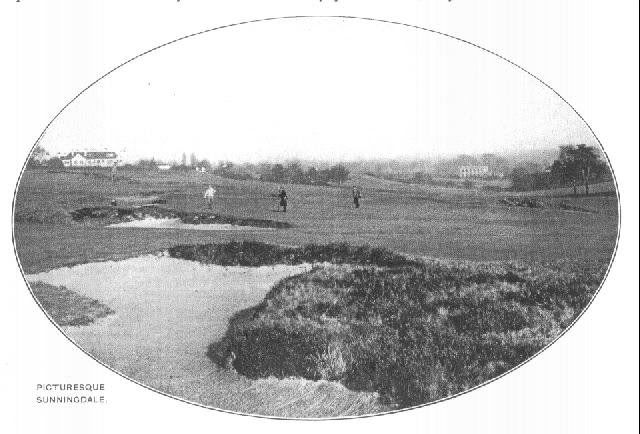
More old pictures
Ouimet again in 1917
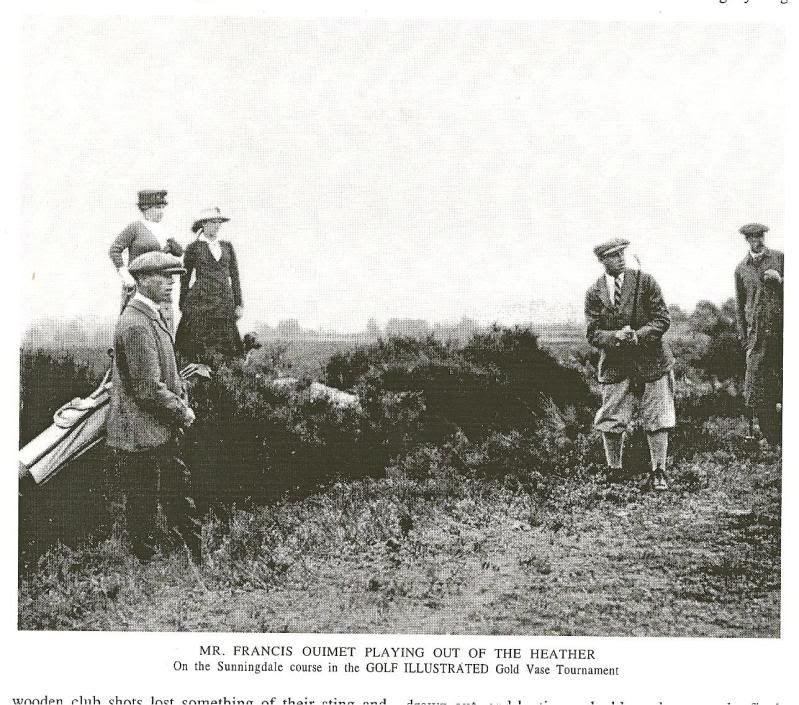
This next shot is from some time prior to the mid 1930’s – Can anyone identify this ‘typical green’?
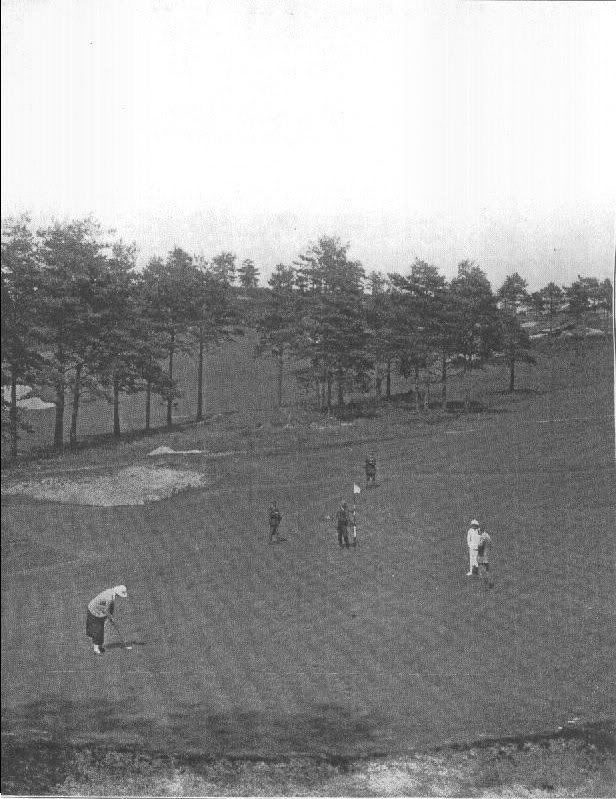
From Tom MacWood's essay, Sunningdale Old:


(Ally/Tom I’m not sure which essay that’s from?)